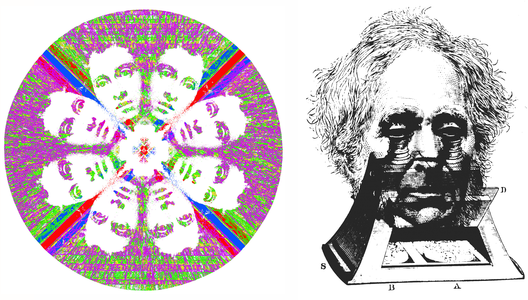David Brewster1781–1868
Brewster was a physicist who devised two of the most popular optical instruments of the nineteenth century - the kaleidoscope and the lenticular form of the stereoscope. They were known as philosophical toys, because they combined science with amusement. His principal interest was in the phenomenon of polarization, and he supported Newton’s corpuscular theory of light in opposition to Young’s wave theory. Brewster wrote on visual as well as physical optics and his pen, from which he made his living, was applied with polemic and perspicacity to far broader human endeavours. For example, he referred to Bell’s experiments on the influence of the eye muscles on visual direction as physiological phantasies, largely because Brewster considered that the seat of vision is in the eye rather than being determined more centrally. He applied the concept of visible direction to a wide variety of phenomena, including stereoscopic vision: objects viewed with two eyes were seen at the intersection of the monocular visible directions. Although he did not add substantially to theory in the context of binocular vision, he did devise, in 1849, the most popular design of stereoscope used in nineteenth century households. It consisted of a single lens cut in half so that the two half-lenses, when appropriately mounted, acted as magnifiers as well as prisms, fusing adjacent stereophotographs. Brewster also made forays into colour vision, suggesting that sunlight was composed of three colours (red, yellow, and blue), and introducing the term colour blindness into our language. Formerly, it was referred to as Daltonism, after the chemist John Dalton (1766-1844), who described his own inability to distinguish red from black. Colour blindness was preferred because “no person wishes to be immortalized by his imperfection”. Brewster was born in Jedburgh, Scotland and studied divinity at Edinburgh University. His diffidence when preaching led him to give up the ministry in favour of natural philosophy. He earned his living as an editor of scientific journals and as a prolific writer. His first academic post was as Principal at St. Andrews University in 1839, and he later became Principal at Edinburgh University. The kaleidoscope is a simple optical instrument involving two plane mirrors inclined at an angle like 45 degrees (which can be divided into 360 degrees) and located in a tube. Viewing through one end of the tube multiplies the images of objects at the other. In the case of the left portrait, the original of which was painted at about the time the kaleidoscope was invented, the face is reflected and rotated successively to give eight images. As with most of Brewster’s inventions there was controversy regarding its originality. An older Brewster is shown with his lenticular stereoscope in the right illustration.
